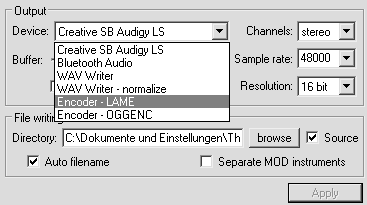Skins (156)
Visuals (115)
Input Plug-ins (34)
Output Plug-ins (6)
General Plug-ins (14)
Archive Reader (15)
Input Plug-ins (41)
DSP Plug-ins (10)
External Add-ons (16)
XMPlay Archive (71)
Skins (156)
Visuals (115)
Input Plug-ins (34)
Output Plug-ins (6)
General Plug-ins (14)
Archive Reader (15)
Input Plug-ins (41)
DSP Plug-ins (10)
External Add-ons (16)
XMPlay Archive (71)
Illustrated Manual - Output - Encoders
Select the output for the filetype you require. For example "WAV writer" for .wav files, or "External - LAME" for .mp3 encoded files.
Tip: Before you are able to encode Ogg Vorbis or MP3 files you will need the the Ogg Vorbis or Lame command line encoders.
How to set up external encoders

You may now start encoding/writing the file by pressing play, or doubleclicking the song in the playlist. You may also press apply while the song is playing to encode from that point, and may also select the starting point by pausing in the song.
Once started, XMPlay will ask you the destination of the file. If you have already given a destination to the external encoder or ticked the "Source" option, no request for a destination will be made.
If the song has no logical end (a SID or SPC file for example), XMPlay will continue to encode/write until you have no harddrive space left, or until you press stop.
Tip: If the Skip filename selection (auto filename) is enabled, the files will be written in the directory selected previously. If no %o tag is used in the settings, the last used output directory will be used.
XMPlay's timer will show its progress through the current song and stops when finished. You may also cancel writing at any time by pressing stop.
Tip: Pressing cancel stops writing but will not delete what has already been written.